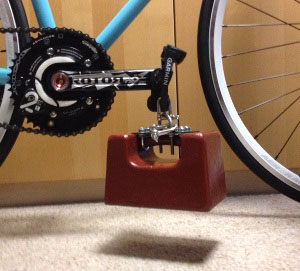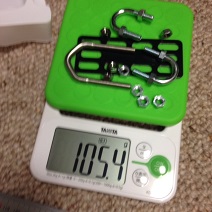It’s often said that for day-to-day training, the important property of a power meter is precision (i.e. repeatability of measured values) and not absolute accuracy (i.e. correct value). I do agree but … what if you had several bikes with power meters fitted to each (okay, that’s actually another reason to swap a hub- or pedal-based power meter!) or wanted to review your long term performance changes 10 years from now?
Some power meters allow to check their absolute measurements after doing a zero-reset (example: Pioneer displays force in [N]), some even allow you to specify a scaling parameter after checking (example: Vector displays torque in [Nm] and allows to store a scaling factor in the pedal to correct their output). Some, like the older P2Ms, unluckily don’t do any of this.
Garmin has a manual on the internet for the recommended procedure. Although they mention the difficulty of measuring a heavy weight of over 10 kgs to the required precision, in their example they are using a large weight, and hanging that from a pedal requires hanging the bicycle high up in the air while attaching the weight … nothing I’d be keen to try.
One alternative could be to just use a calibrated weight that’s used for checking scales, which looks like this:
 This one here is a 10 kg weight (which I admit is a bit on the light side, even as a light weight cyclist with a not too high maximum power number; 10 kg is equivalent to between 150 and 200 W at cadence 100 for ideal completely round pedaling or probably about 50 W at cadence 70 for typical not-round pedaling) accurate to plus minus 1.6g (guaranteed for one year by the manufacturer), which is far above the accuracy needed for this procedure. A 20 kg weight would only measure about 25% more in height/width/depth each and still be compact enough to measure both tangential force (as seen in the picture with a horizontal crank) or radial force (with the crank in upward position) with the wheels on the floor.
This one here is a 10 kg weight (which I admit is a bit on the light side, even as a light weight cyclist with a not too high maximum power number; 10 kg is equivalent to between 150 and 200 W at cadence 100 for ideal completely round pedaling or probably about 50 W at cadence 70 for typical not-round pedaling) accurate to plus minus 1.6g (guaranteed for one year by the manufacturer), which is far above the accuracy needed for this procedure. A 20 kg weight would only measure about 25% more in height/width/depth each and still be compact enough to measure both tangential force (as seen in the picture with a horizontal crank) or radial force (with the crank in upward position) with the wheels on the floor.
Together with the metal hardware like shackles to mount the weight to the pedal, measured on a extra precise kitchen scale, the total weight was 10184.5g plus minus 2.2g or 0.02% accuracy. With power being linear to force and torque, that’s more than accurate enough. (Sorry for the blurry smartphone picture.)
My results for Vector2: Expected 16.485Nm (for crank length 165mm), measured 16.81Nm on right and 16.44Nm on left.
My results for Pioneer: Expected 99.91N, measured tangential 102N / radial -102N on right and 98N / -102N on left.
In both cases, that’s about 2%, which means that without any other error, the final power values could be within 2% error.
Thoughts:
The big question here is of course: even a slight cadence error of 1 rpm will set this off largely, so a 2% error of the final power value is actually unlikely.
I might better use not just a heavier weight, but actually several different weights.
DCRainmaker reported that the yet to come Watteam Powerbeat will use a plastic bag that fills with an exact amount of water to act like a accurate weight. If that works, that’d be nice, although, hanging like 10 kgs = 10 liters doesn’t seem very practical.
Somewhat related: Wahoo used to sell, and probably now rents a weight for calibrating the power meter inside their KICKR trainer whereas Tacx claims their new really direct drive trainer is calibration-free. (The KICKR was only half direct between chain and trainer, but still had a belt driving a flywheel, while the new Tacx is doesn’t really have a flywheel and is completely electronic producing a virtual feeling of inertia by electronic control.) The principle behind the Tacx I guess is that calibration is not necessary if you can control or measure electric current very accurately. A more simplicistic view could be: for a rotation sensor you’d either have a magnet switch or some self-calibration using accelerometers and gravitational force, so why having to calibrate a power meter, isn’t that just poor engineering?
